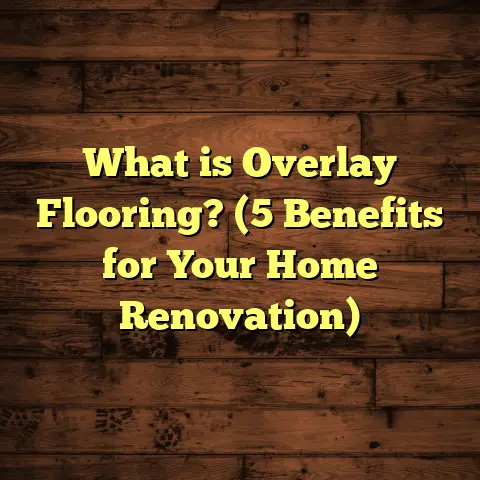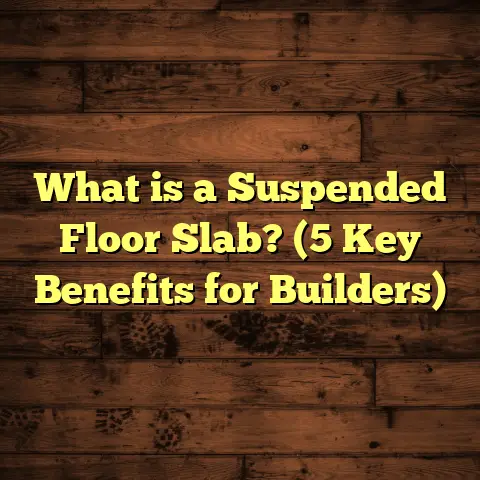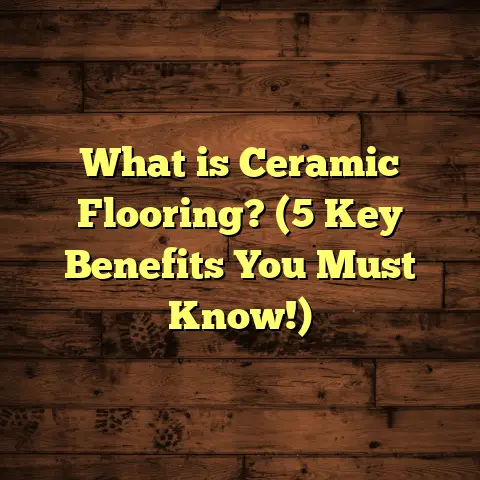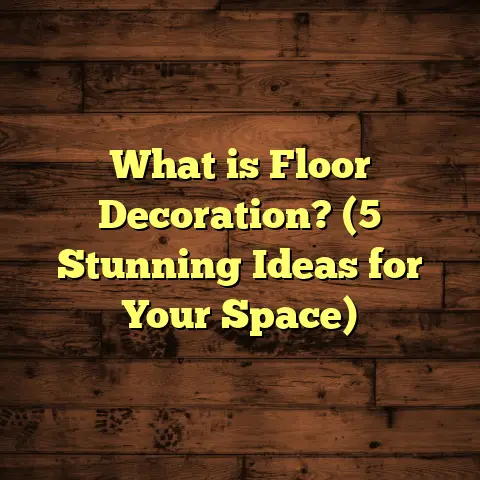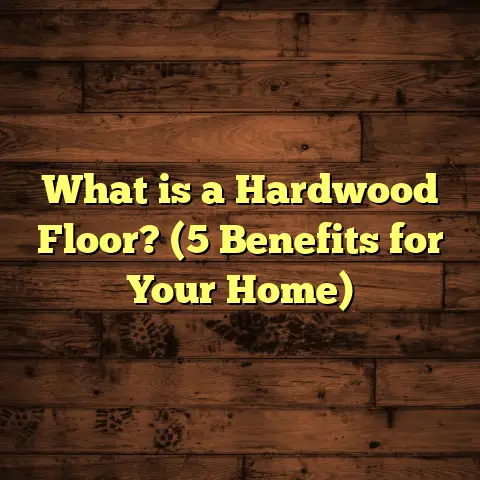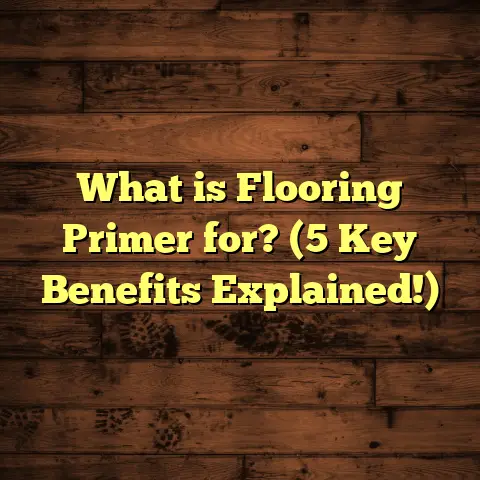What is Carbonized Strand Bamboo Flooring? (5 Amazing Benefits!)
Spring’s here, and you know what that means for flooring trends—time to refresh interiors with something fresh yet durable. Over the years, I’ve installed countless floors, but one material that keeps catching my eye is carbonized strand bamboo flooring. It’s got this rich, warm tone that naturally fits into the lighter, airy vibes people crave in spring and summer. But beyond looks, it has qualities that make it a serious contender if you’re thinking about upgrading your floors.
I remember my first carbonized strand bamboo job about five years ago in Portland, Oregon. The client wanted a natural look but something harder and more stable than traditional hardwood. After a couple of weeks on-site and lots of tweaks, the floor was done. The process taught me a lot about the material’s strengths and what makes it different from other bamboo options or hardwood. Let me walk you through what I’ve learned.
The Science Behind Carbonized Strand Bamboo Flooring
Unlike regular bamboo flooring, carbonized strand bamboo undergoes a unique heat treatment process. The strands of bamboo are shredded, mixed with adhesives, and then pressed together under heat and pressure. This process caramelizes the sugars in the bamboo fibers, giving the floor its distinctive darker hue.
Typical plank sizes I’ve worked with range from about 48 inches long by 5 inches wide, with thicknesses between 0.5 to 0.75 inches. It’s usually sold as engineered planks with a multi-layer core for extra stability. For a 1,200-square-foot home, installation can take around 3 to 5 days depending on subfloor prep, room complexity, and acclimation time.
One thing I’ve noticed is how the carbonization process slightly reduces the bamboo’s hardness compared to natural strand bamboo. On the Janka hardness scale, natural strand bamboo scores around 1,380 to 1,400 lbf, while carbonized versions drop to about 1,200 to 1,250 lbf. Still harder than many hardwoods like red oak (1,290 lbf), but it’s good to know if you’re expecting extreme wear resistance.
History and Evolution of Strand Bamboo Flooring
Strand woven bamboo flooring came onto the market in the early 2000s as a more durable alternative to traditional bamboo planks. Initially popular in Asia and parts of Europe, it gained traction in North America around 2010.
Carbonization, however, has been used for decades in woodworking to improve color and appearance naturally without stains.
When these two techniques were combined—strand weaving plus carbonization—it created a flooring material that was not only hard but also visually appealing in a warm amber tone.
I’ve sourced some old catalogs from suppliers dating back to 2012 that show prices for carbonized strand bamboo at around $4 per square foot for materials alone—today prices have risen but remain competitive.
Why I Keep Recommending It: Five Benefits That Stood Out
Warmth and Color That Age Beautifully
The caramelization process creates rich amber to deep brown tones that deepen over time. I installed a project in San Francisco three years ago where the homeowner loved how the floor “warmed” the space without darkening it too much.
Unlike stained wood, the color is integral to the bamboo strands, so scratches or dents don’t reveal a lighter color underneath.
One client told me recently that after three years with kids running around and pets scratching occasionally, their floor still looked better than their friend’s oak floor after just one year.
Environmentally Friendly Choice
Bamboo grows fast—some species mature in as little as five years compared to 20-50 years for hardwoods. I often highlight this fact when clients ask about sustainability. The carbonization process doesn’t add toxic chemicals; it’s just heat and pressure altering the material naturally.
In my recent project in Seattle covering 900 square feet, local suppliers sourced bamboo grown in China but certified by FSC (Forest Stewardship Council) standards. That’s key for me when advising clients who want eco-friendly options without sacrificing quality.
To give you an idea of impact: harvesting one acre of mature bamboo produces about 30% more oxygen and sequesters more carbon dioxide than an equivalent hardwood forest plot.
Durability That Lasts
While carbonized strand bamboo isn’t quite as hard as its natural counterpart, it still holds up well in busy households. From my experience, these floors resist dents and scratches better than traditional solid hardwoods like maple or walnut.
For example, a family in Denver installed it in their living room and kitchen (totaling 800 sq ft) about two years ago. Their kids and pets put the floor through daily use with minimal wear—something they were very happy about after using softer wood floors before.
I’ve also seen commercial installations in boutique coffee shops where it handles heavy foot traffic without problems for over four years now.
Easy Installation and Maintenance
Carbonized strand bamboo often comes as engineered planks with click-lock systems or tongue-and-groove edges for glue-down installation. In my experience, installation is faster than solid hardwood because the planks adapt better to subfloor irregularities.
I typically recommend acclimating the planks on-site for at least 72 hours before laying them down to avoid expansion issues later on.
Maintenance-wise, sweeping and damp mopping with a gentle cleaner keeps floors looking new for years.
One detail I learned from a client in Chicago was that avoiding harsh chemical cleaners preserves the finish better than frequent waxing or refinishing attempts.
Cost-Effective Alternative with High-End Appeal
Pricing depends on region and vendor but expect carbonized strand bamboo flooring to run between $5 to $8 per square foot for materials. Installation labor usually adds $3 to $6 per square foot, depending on project complexity.
In a recent client project in Austin covering 1,000 square feet, total costs (materials + labor) came out around $7,500—competitive with mid-range hardwood but with better environmental credentials.
I often use FloorTally when estimating these projects. It helps me quickly calculate costs based on local labor rates and material prices, factoring in waste percentages and installation methods. This keeps my client budgets realistic and avoids surprises mid-project.
Let me share how FloorTally fit into one project:
In a 1,200 sq ft remodel last year in Nashville, I plugged all numbers into FloorTally—including material costs at $6/sq ft, labor at $4/sq ft, plus an 8% waste factor.
The tool generated an accurate estimate within hours that helped my client secure financing confidently before ordering materials or booking installers.
What Sets Carbonized Strand Bamboo Apart from Other Bamboo Options?
There are plenty of bamboo floors out there—solid strip, horizontal and vertical grain, and strand woven—but carbonized strand bamboo stands out due to its unique manufacturing process and resulting aesthetics.
Strand woven flooring is already known for its density and strength—it’s made by shredding bamboo stalks and compressing them into dense blocks. Adding carbonization means you get that durability with a warmer tone naturally baked in.
Compared to horizontal or vertical grain bamboo that has more visible grain patterns, carbonized strand bamboo offers a more uniform look with subtle texture variations, which many designers prefer for modern interiors.
I once worked with an interior designer in Miami who wanted her client’s beach house floor to have a consistent tone that complemented whitewashed walls and light furnishings. Carbonized strand bamboo fit perfectly without overshadowing other design elements.
Installation Process: How I Handle Carbonized Strand Bamboo Floors
Let me walk you through my installation routine since it can make or break your finished floor.
Step 1: Subfloor Preparation
This is where many DIYers stumble. The subfloor must be clean, dry, level within 3/16 inch over 10 feet, and structurally sound. For concrete slabs or plywood subfloors, I use moisture meters to check dampness. If moisture levels are above recommended levels (usually above 4% moisture content for plywood or 3 lbs/1000 sq ft/24 hrs for concrete), I pause work until resolved.
In one Chicago project during wintertime basement installation, we had to install a vapor barrier underlayment due to high slab moisture readings. That extra step added two days but ensured no future warping or mold issues.
Step 2: Acclimation
Carbonized strand bamboo planks need at least 48-72 hours acclimation indoors prior to installation. This lets them adjust to temperature and humidity conditions to minimize expansion or contraction later.
I store bundles away from direct sunlight or heat sources during this time. Some clients skip this step and regret it when gaps appear after heating season begins.
Step 3: Layout Planning
I always measure multiple times before starting. Deciding plank direction—usually parallel to longest wall or main light source—is critical for aesthetics. I chalk lines for straight rows and plan how staggered seams will fall. This planning reduces wastage and nails down timeline expectations.
Step 4: Installation Methods
Carbonized strand bamboo can be installed as:
- Floating floor with click-lock system
- Glue-down over suitable substrates
- Nail-down (less common due to engineered plank core)
For floating floors, I leave a 3/8 inch expansion gap around perimeter. For glue-down jobs (common over concrete), I use high-quality adhesives recommended by manufacturers. Nail-down requires pneumatic flooring nailers and proper subfloor thickness.
Step 5: Finishing Touches
After installation I install baseboards or quarter-round moldings to cover expansion gaps. Occasionally sanding or refinishing isn’t necessary unless wear occurs after years of use. Sealing edges near wet areas like kitchens prevents water damage or swelling.
Maintenance Routine That Keeps Floors Looking Great
From my experience working with dozens of homeowners:
- Sweep or vacuum regularly to remove grit that can scratch finish
- Use microfiber mops slightly dampened with manufacturer-approved cleaners
- Avoid steam mops or excessive water which damages wood fibers
- Place rugs at entrances and heavy traffic zones
- Use felt pads under furniture legs
- Clean spills immediately to avoid staining or warping
One client shared how following these tips helped her carbonized strand bamboo floor look practically new after five years despite daily use by kids and pets.
Cost Breakdown: What You Should Expect Financially
Let’s talk numbers in more detail based on actual projects I’ve handled:
| Cost Component | Typical Range (USD) | Notes |
|---|---|---|
| Materials | $5 – $8 per sq ft | Depending on quality & finish |
| Installation Labor | $3 – $6 per sq ft | Influenced by region & prep |
| Subfloor Prep | $500 – $1,500 | Moisture barriers & leveling |
| Underlayment | $0.50 – $1 per sq ft | For floating installations |
| Waste Factor | ~5-10% material cost | Accounted during budgeting |
So for a typical 1,200 sq ft house:
- Materials: $7,200 (at $6/sq ft average)
- Labor: $5,400 (at $4.50/sq ft average)
- Subfloor Prep + Underlayment: ~$1,200 total
Total Estimated Cost: Around $13,800
Using tools like FloorTally helped me run these numbers fast and adjust based on local labor market differences. It also allows me to include waste percentages so clients can order the right amount without costly shortages or excess.
Comparing Carbonized Strand Bamboo with Other Popular Floors
How does this option stack up against others?
| Flooring Type | Hardness (Janka) | Cost per Sq Ft | Durability | Maintenance | Environmental Impact |
|---|---|---|---|---|---|
| Carbonized Strand Bamboo | ~1,200 lbf | $8 – $14 (installed) | High | Moderate | High (fast-growing plant) |
| Red Oak Hardwood | ~1,290 lbf | $10 – $15 | Moderate | Moderate | Moderate |
| Laminate Flooring | N/A | $3 – $7 | Moderate | Easy | Low |
| Vinyl Plank Flooring | N/A | $4 – $10 | Moderate | Easy | Low |
| Ceramic Tile | N/A | $5 – $12 | Very High | Easy | Moderate |
Carbonized strand bamboo offers a middle ground between natural wood warmth and durability without synthetic feel some dislike in laminates or vinyls. Its environmental benefits also appeal to green-conscious buyers. You get style without compromising function or conscience.
My Personal Stories with Carbonized Strand Bamboo Flooring
A few memorable projects stand out:
- Portland Remodel: A couple wanted floors that could handle their growing twins running wild indoors. Carbonized strand bamboo was perfect—it resisted dents and cleaned easily even after muddy shoe days.
- Miami Beach Condo: Designer chose carbonized strand bamboo for its sleek uniform color that enhanced coastal decor. Despite humidity challenges near oceanfront locations, floors remained stable thanks to engineered core construction.
- Denver Family Home: After three years of pet claws on their kitchen floor, they reported barely noticeable wear compared to previous hardwood floors they’d replaced.
These stories remind me why I enjoy working with this flooring—every home has different challenges, and this material adapts surprisingly well across climates and lifestyles.
Frequently Asked Questions About Carbonized Strand Bamboo Flooring
Q: Does carbonization weaken the bamboo?
A: Slightly reduces hardness but increases color depth. Still very durable overall.
Q: Can I install carbonized strand bamboo over radiant heat?
A: Most engineered versions tolerate it well but check specific product guidelines first.
Q: How long does installation take?
A: Usually 3–5 days for an average-sized house including prep & acclimation.
Q: Is it prone to fading in sunlight?
A: Less so than stained wood floors since color is internal but UV protection helps extend life.
Q: What finishes are available?
A: Matte, semi-gloss, hand-scraped textures are common options depending on supplier.
Wrapping Up My Take on Carbonized Strand Bamboo Flooring
Over time, I’ve grown fond of carbonized strand bamboo flooring not just for its warm look but for how well it performs day-to-day. It balances style, durability, and sustainability in a way that feels right for many homeowners today.
If you’re debating whether to go for it, think about your lifestyle needs: kids? pets? How much wear can your floors take? And don’t forget to factor in your budget realistically— FloorTally has always been my go-to tool for this because it helps me lay out costs clearly before any work begins.
Feel free to ask if you want me to break down installation steps or share more stories from the field—I’m always happy to chat flooring!
